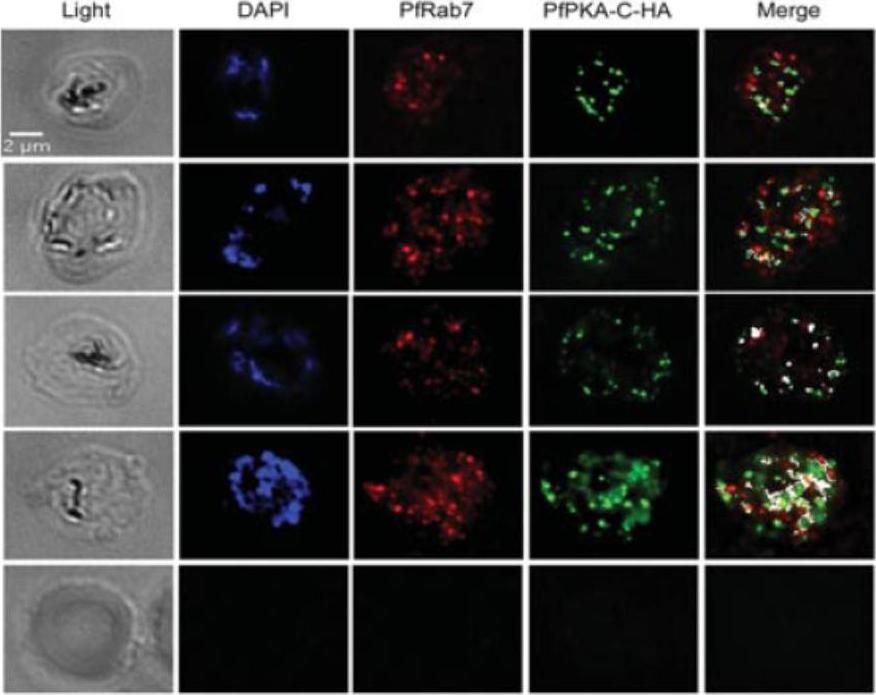PY17X_0839000 cAMP-dependent protein kinase catalytic subunit (PKAc)
Disruptability [+]
| Species | Disruptability | Reference | Submitter | |
|---|---|---|---|---|
| P. berghei ANKA |
Refractory |
RMgm-543 | Imported from RMgmDB | |
| P. berghei ANKA |
Refractory |
PlasmoGEM (Barseq) | PlasmoGEM | |
| P. falciparum 3D7 |
Refractory |
22127061 | Theo Sanderson, Wellcome Trust Sanger Institute | |
| P. falciparum 3D7 |
Refractory |
USF piggyBac screen (Insert. mut.) | USF PiggyBac Screen | |
Mutant phenotypes [+]
| Species | Stage | Phenotype | Reference | Submitter |
|---|---|---|---|---|
| P. falciparum 3D7 | Asexual |
Invasion defect |
31075098 Normal egress, calcium mobilisation, microneme discharge, and rhoptry secretion. AMA1 phosphorylation affected. Lethal. |
Theo Sanderson, Google AI |
Imaging data (from Malaria Metabolic Pathways)

Association between PfRab7 and PfPKA-C-HA in vivo is shown at a single stack of image acquisition. The distribution of PfRab7 (red) is revealed with a specific anti-peptide PfRab7 antibody and the distribution of PfPKA-C-HA (green) is revealed with anti-HA antibodies. The association between PfRab7 and PfPKA-C-HA is shown in white. The level of association between Rab7 and PfPKA-C-HA increases as the parasite develops into a multi-nucleated schizont (nuclei shown stained in blue with DAPI). One can observe a subset of PfRab7+ vesicles associated with a subset of PfPKA-C-HA+ structures. The ability of PfRab7 to bind PfPKA-C suggests that it acts somewhat like a PKA-anchor proteins (AKAP), recruiting PKA to early and late endosomes.Rached FB, Ndjembo-Ezougou C, Chandran S, Talabani H, Yera H, Dandavate V, Bourdoncle P, Meissner M, Tatu U, Langsley G. Construction of a Plasmodium falciparum Rab-interactome identifies CK1 and PKA as Rab-effector kinases in malaria parasites. Biol Cell. 2012 104(1):34-47.
See original on MMP
STAD-2 does not associate with PKA. (A) Late-stage iRBC were treated with 1 μM FITC-conjugated STAD-2 for 2 hours and probed for P. falciparum PKA-R. STAD-2 did not show clear colocalization with the regulatory subunit.Flaherty BR, Wang Y, Trope EC, Ho TG, Muralidharan V, Kennedy EJ, Peterson DS. The Stapled AKAP Disruptor Peptide STAD-2 Displays Antimalarial Activity through a PKA-Independent Mechanism. PLoS One. 2015 10(5):e0129239.
See original on MMPMore information
| PlasmoDB | PY17X_0839000 |
| GeneDB | PY17X_0839000 |
| Malaria Metabolic Pathways | Localisation images Pathways mapped to |
| Previous ID(s) | null |
| Orthologs | PBANKA_0835600 , PCHAS_0835900 , PF3D7_0934800 , PKNH_0733500 , PVP01_0733500 , PVX_086975 |
| Google Scholar | Search for all mentions of this gene |